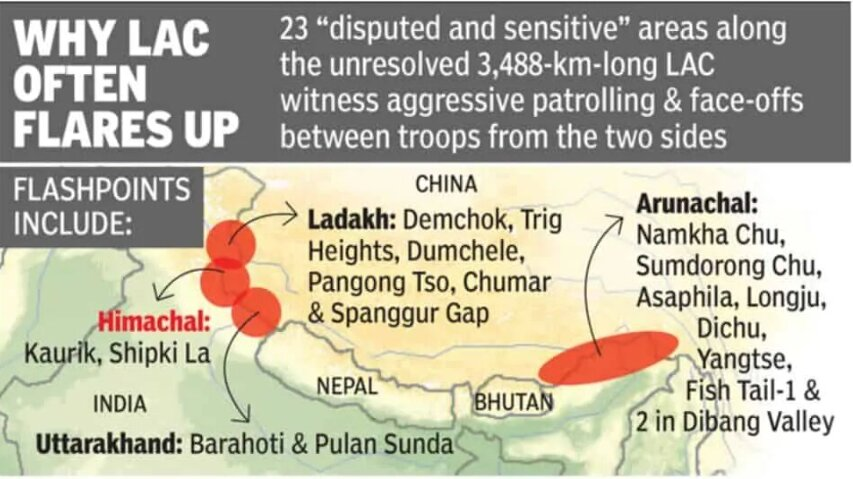Indo-China Defence Ministerial Meet | 05 Sep 2020
Why in News
The Indo-China Defence Minister level meet happened on the sidelines of the Shanghai Cooperation Organisation (SCO) Defence Ministers’ meeting in Moscow (Russia) on 4th September 2020.
Key Points
- Significance of the Meet: The first high-level political face-to-face meeting between India and China since the border row erupted along the Line of Actual Control (LAC) in eastern Ladakh.
- India pushed for the restoration of status quo ante at all friction points along the Line of Actual Control (LAC) in eastern Ladakh and called for disengagement of troops in an expeditious way.
- Background:
- The Indian and Chinese armies are engaged in the standoff at Pangong Tso, Galwan Valley, Demchok and Daulat Beg Oldie in eastern Ladakh.
- The actions on the northern bank of Pangong Tso are not just for territorial gains on land, but enhanced domination of the resource-rich lake.
- Pangong Tso is overlooked by the Finger Area - a set of eight cliffs extending out of the Sirijap range (on the northern bank of Lake).
- The stand-off at Ladakh’s Galwan Valley has escalated in recent weeks due to the infrastructure projects that India has undertaken in the recent years. India is building a strategic road, Darbuk-Shyok-Daulat Beg Oldie (DSDBO) road, through the Galwan Valley - close to China - connecting the region to an airstrip.
- China is opposed to any Indian construction in the area. A stand-off in the Galwan area was one of the biggest flashpoints of the 1962 war.
Line of Actual Control
- The LAC is the demarcation that separates Indian-controlled territory from Chinese-controlled territory. India considers the LAC to be 3,488 km long, while the Chinese consider it to be only around 2,000 km.
- It is divided into three sectors:
- The eastern sector which spans Arunachal Pradesh and Sikkim.
- The middle sector in Uttarakhand and Himachal Pradesh.
- The western sector in Ladakh.
- The India-China LAC in Ladakh is an outcome of the territory illegally retained by China after the 1962 conflict. The Chinese occupation of parts of Aksai Chin is not supported by historical or legal documents.
India’s Statement at SCO
- Peace and Prosperity: India stressed upon a peaceful, stable and secure region of SCO member states.
- Prosperity and stability in the region demand a climate of trust and cooperation, non-aggression, respect for international rules, sensitivity to each other’s interest and peaceful resolution of differences.
- India is committed to the evolution of a global security architecture which will be open, transparent, inclusive, rules-based and anchored in international laws.
- On the Regional Situation: India expressed concern at
- The security situation in Afghanistan.
- The SCO contact group on Afghanistan is useful for arriving at a formal agreement among SCO member States.
- It was conceived In 2005 and was brought into action in 2017 at the level of deputy foreign ministers.
- The Group envisages joint actions to enhance cooperation in security, trade, the economy as well as cultural and humanitarian ties.
- Gulf Region: India called upon the Gulf countries to resolve differences between them by “dialogue based on mutual respect, sovereignty and non-interference in internal affairs of each other".
- The security situation in Afghanistan.
- Terrorism: India unequivocally condemns terrorism in all forms and manifestations, and condemns its proponents and asserted the need to build institutional capacity to deal with both traditional and non-traditional threats — above all, terrorism, drug-trafficking and transnational crime.
Shanghai Cooperation Organization
- It was formed in the year 2001 and headquartered at Beijing, China.
- Geographic Extent: SCO is a significant organization that has a vast geographic expanse and is important for Central Asia, South-Asia and Asia-Pacific region.
- It is a major Eurasian organization that represents half of the world’s population.
- It is a permanent intergovernmental international organisation.
- Member-states: The SCO has eight members namely India, Kazakhstan, China, Kyrgyzstan, Pakistan, Russia, Tajikistan and Uzbekistan, and four observer states - Afghanistan, Belarus, Iran and Mongolia.
- India joined SCO in 2017 at the insistence of Russia, and China balanced India’s entry with the entry of Pakistan.
- Permanent Bodies: The organisation has two permanent bodies — the SCO Secretariat based in Beijing (China) and the Executive Committee of the Regional Anti-Terrorist Structure (RATS) based in Tashkent (Uzbekistan).
- Significance: It has the capacity to counterbalance the North Atlantic Treaty Organization.
- Mandate: SCO has an evolving mandate which started off by being an economic, political, cultural and regional security organization.
Way Forward
- In April 2020, India and China completed their 70 years of diplomatic relations. Both sides should acknowledge that the situation is precarious, and that the recent days in particular have undone decades of painstakingly negotiated confidence-building mechanisms.
- For India, the first priority has to be to restore the status quo ante at the border as it existed in April 2020. This will require both a display of military strength at the border by standing up to Chinese aggression, and diplomatic work by making it clear to China that its intervention will lead to heavy costs across all spheres of the relationship.
- Through the platform of SCO, India has a clear opportunity to highlight the real values of Indian Foreign Policy.

